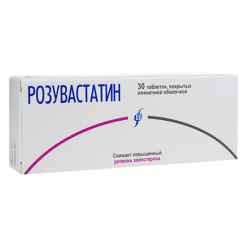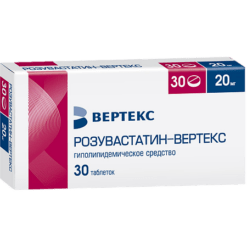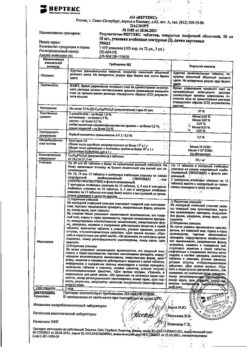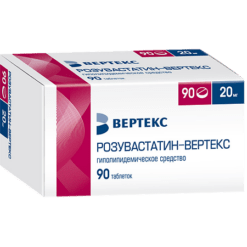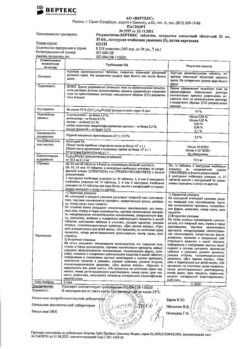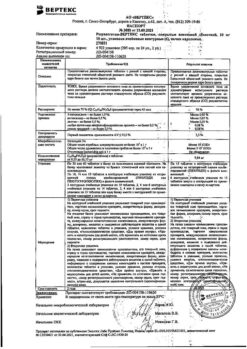No products in the cart.
Rosuvastatin, 10 mg 30 pcs
€19.74 €16.45
Out of stock
(E-mail when Stock is available)
Description
Pharmgroup:
Hypolipidemic drug – HMG-CoA reductase inhibitor.
Pharmic action:
Hypolipidemic drug, a selective competitive inhibitor of HMG-CoA reductase, which converts 3-hydroxy-3-methylglutarylCoA to mevalonate, a precursor of cholesterol.
The main target of action is the liver, where cholesterol synthesis and LDL catabolism take place. It inhibits HMG-CoA reductase activity (90% of the drug circulates in the blood).
increases the number of LDL receptors on the surface of hepatocytes, increasing the capture and catabolism of LDL, which leads to inhibition of LDL synthesis, reducing the total amount of LDL and LDL.
. Reduces concentrations of LDL-C, non-LDL cholesterol, LDL cholesterol, total cholesterol, TG, TG-LDL-C, apolipoprotein B (ApoB), LDL cholesterol/LDL cholesterol/LDL cholesterol ratio, total cholestrin/LDL cholesterol, non-LDL cholesterol/LDL cholesterol, apoB/apoA-I, increases the concentration of HDL cholesterol, apoA-I. Hypolipidemic effect is directly proportional to the value of the prescribed dose.
Therapeutic effect appears within 1 week after the start of therapy, after 2 weeks it reaches 90% of the maximum, the maximum effect is usually reached by 4 weeks and thereafter remains constant.
It is effective in adult patients with hypercholesterolemia with or without hypertriglyceridemia (regardless of race, sex or age), including patients with diabetes and familial hypercholesterolemia.
Additive effect is noted in combination with fenofibrate (with respect to reduction of TG concentration) and nicotinic acid (with respect to reduction of HDL cholesterol concentration).
Pharmacokinetics:
The bioavailability is 20%. Food reduces the rate of absorption. Binding with plasma proteins (mainly with albumin) – 90%. TCmax is 3-5 hours. It penetrates through placental barrier. It is accumulated in the liver. Volume of distribution – 134 l.
It is metabolized in the liver in 10% of the administered dose. As in the case of other HMG-CoA reductase inhibitors, a specific membrane cholesterol transporter is involved in the hepatic uptake of the drug, which plays an important role in its hepatic elimination. Rosuvastatin has been shown to be a non-core substrate for metabolism by enzymes of cytochrome P450 system.
The main isoenzyme involved in metabolism of rosuvastatin is CYP2C9. CYP2C19, CYP3A4, CYP2D6 enzymes are less involved in metabolism. The main metabolite is N-desmethyl, which has 1/6-1/2 of the activity of rosuvastatin; lactone metabolites are pharmacologically inactive. T1/2 is 19 h (does not change with increasing drug dose). Mean geometric plasma clearance is 50 l/h.
Extracted mainly unchanged (90%) in the feces (including adsorbed and unadsorbed rosuvastatin); the remainder in the urine. It is not excreted by hemodialysis.
Gender and age have no clinically significant effect on the pharmacokinetics of rosuvastatin.
Pharmacokinetic parameters depend on race: AUC in Japanese and Chinese is 2 times higher than in Europe and North America.
In patients with mild to moderately severe renal impairment plasma concentrations of rosuvastatin or N-dismethyl do not change significantly. In patients with severe renal impairment (CK<30 ml/min) plasma concentrations of rosuvastatin are 3 times higher and N-dismethyl – 9 times higher than in healthy volunteers. Plasma concentrations of rosuvastatin in patients on hemodialysis are approximately 50% higher than in healthy volunteers.
In patients with various stages of hepatic failure with Child-Pugh score 7 and lower there was no increase of T1/2 of rosuvastatin; in 2 patients with Child-Pugh scores 8 and 9 it was observed prolongation of T1/2 by 2 times. There is no experience of using the drug in patients with more severe liver dysfunction.
Indications
Indications
Primary hypercholesterolemia (type IIa, including familial heterozygous hypercholesterolemia) or mixed hypercholesterolemia (type IIb) as an addition to diet when diet and other non-drug treatments (exercise, weight loss) are insufficient.
Familial homozygous hypercholesterolemia as an adjunct to diet and other cholesterol-lowering therapy (LDL apheresis) or in cases where such therapy is not suitable for the patient.
Pharmacological effect
Pharmacological effect
Pharmaceutical group:
lipid-lowering agent – HMG-CoA reductase inhibitor.
Pharmaceutical action:
A lipid-lowering drug, a selective competitive inhibitor of HMG-CoA reductase, which converts 3-hydroxy-3-methylglutarylCoA into mevalonate, a cholesterol precursor.
The main target of action is the liver, where cholesterol synthesis and LDL catabolism occur. Inhibits the activity of HMG-CoA reductase (90% of the drug circulates in the blood).
Increases the number of LDL receptors on the surface of hepatocytes, increasing the uptake and catabolism of LDL, which leads to inhibition of VLDL synthesis, reducing the total number of LDL and VLDL.
Reduces the concentration of LDL cholesterol, non-HDL cholesterol, VLDL cholesterol, total cholesterol, TG, VLDL TG, apolipoprotein B (ApoB), LDL cholesterol/HDL cholesterol ratio, total cholesterol/HDL cholesterol, non-HDL cholesterol/HDL cholesterol, ApoB/ApoA-I, increases the concentration cholesterol-HDL, ApoA-I. The lipid-lowering effect is directly proportional to the prescribed dose.
The therapeutic effect appears within 1 week after the start of therapy, after 2 weeks it reaches 90% of the maximum, the maximum effect is usually achieved by 4 weeks and after that remains constant.
Effective in adult patients with hypercholesterolemia with or without hypertriglyceridemia (regardless of race, gender or age), incl. in patients with diabetes mellitus and familial hypercholesterolemia.
An additive effect is observed in combination with fenofibrate (in relation to reducing the concentration of TG) and nicotinic acid (in relation to reducing the concentration of HDL cholesterol).
Pharmacokinetics:
Bioavailability – 20%. Food reduces the rate of absorption. Communication with plasma proteins (mainly albumin) – 90%. TCmax – 3-5 hours. Penetrates the placental barrier. Accumulates in the liver. Distribution volume – 134 l.
10% of the administered dose is metabolized in the liver. As in the case of other HMG-CoA reductase inhibitors, a specific membrane cholesterol transporter is involved in the process of hepatic uptake of the drug, which plays an important role in its hepatic elimination. It has been shown that rosuvastatin is a non-core substrate for metabolism by enzymes of the cytochrome P450 system.
The main isoenzyme involved in the metabolism of rosuvastatin is CYP2C9. Enzymes CYP2C19, CYP3A4, CYP2D6 are involved in metabolism to a lesser extent. The main metabolite is N-desmethyl, which has 1/6-1/2 the activity of rosuvastatin; lactone metabolites are pharmacologically inactive. T1/2 – 19 hours (does not change with increasing dose of the drug). The geometric average plasma clearance is 50 l/h.
It is excreted predominantly unchanged (90%) in feces (including adsorbed and non-adsorbed rosuvastatin); the rest is in urine. Not excreted by hemodialysis.
Gender and age do not have a clinically significant effect on the pharmacokinetics of rosuvastatin.
Pharmacokinetic parameters depend on race: AUC in Japanese and Chinese is 2 times higher than that in residents of Europe and North America.
In patients with mild to moderate renal failure, plasma concentrations of rosuvastatin or N-dismethyl do not change significantly. In patients with severe renal failure (creatinine clearance <30 ml/min), the plasma concentration of rosuvastatin is 3 times higher, and N-dismethyl is 9 times higher than in healthy volunteers. Plasma concentrations of rosuvastatin in hemodialysis patients are approximately 50% higher than in healthy volunteers.
In patients with various stages of liver failure with a score of 7 and below on the Child-Pug scale, no increase in T1/2 of rosuvastatin was detected; in 2 patients with scores of 8 and 9 on the Child-Pug scale, a 2-fold prolongation of T1/2 was noted. There is no experience with the use of the drug in patients with more severe liver dysfunction.
Special instructions
Special instructions
Before starting therapy and throughout the entire period of treatment, you should follow a standard lipid-lowering diet. During treatment, the lipid profile should be monitored every 2-4 weeks and, according to it, the dose of the drug should be adjusted if necessary.
Doses of 40 mg are contraindicated in patients with risk factors for the development of rhabdomyolysis (moderate renal failure (creatinine clearance less than 60 ml/min), hypothyroidism, personal or family history of muscle diseases, myotoxicity while taking other HMG-CoA reductase inhibitors or fibrates, alcohol abuse; conditions accompanied by an increase in the concentration of the drug in the systemic circulation), simultaneous use of fibrates, patients of the Asian race).
In patients taking the drug at a dose of 40 mg, it is recommended to monitor kidney function tests.
Determination of CPK activity should not be carried out after intense physical activity or in the presence of other possible reasons for the increase in CPK, which may lead to incorrect interpretation of the results obtained. If the initial CPK increases 5 times above the upper limit of normal, a repeat measurement should be taken after 5-7 days. Therapy should not be started if a repeat test confirms an initial increase in CPK activity of more than 5 times the upper limit of normal.
In patients with existing risk factors for rhabdomyolysis, it is necessary to consider the balance of risk and possible benefit of therapy and carry out clinical monitoring throughout the course of treatment.
The patient should be informed to immediately report to the doctor the unexpected onset of muscle pain, muscle weakness or cramps, especially in combination with malaise and fever. In such patients, CPK activity should be monitored. Therapy should be discontinued if CPK activity is increased by more than 5 times the upper limit of normal, or if muscle symptoms are severe and cause daily discomfort (even if CPK activity is 5 times less than the upper limit of normal). If symptoms disappear and CPK activity returns to normal, re-prescribing the drug or other HMG-CoA reductase inhibitors in lower doses should be considered with careful monitoring of the patient. Routine monitoring of CPK activity in the absence of symptoms of rhabdomyolysis is not advisable.
An increased incidence of myositis and myopathy has been reported in patients taking other HMG-CoA reductase inhibitors in combination with fibric acid derivatives, including gemfibrozil, cyclosporine, nicotinic acid, azole antifungals, protease inhibitors and macrolide antibiotics. Gemfibrozil increases the risk of myopathy when combined with certain HMG-CoA reductase inhibitors. Therefore, co-administration of rosuvastatin and gemfibrozil is not recommended. The risk/benefit ratio should be carefully weighed when using rosuvastatin and fibrates or nicotinic acid together.
It is recommended to determine liver function indicators before starting therapy and 3 months after starting therapy. If the activity of “liver” transaminases in the blood serum is 3 times higher than the upper limit of normal, the dose of the drug should be reduced or discontinued.
In most cases, proteinuria decreases or disappears during therapy and does not indicate the onset of acute or progression of existing kidney disease.
When hypercholesterolemia is combined with hypothyroidism or nephrotic syndrome, therapy for underlying diseases should be carried out before starting treatment with rosuvastatin.
Caution should be exercised when driving or doing work that requires increased concentration and psychomotor reaction (dizziness may occur during therapy).
Women of reproductive age should use adequate methods of contraception. Since cholesterol and substances synthesized from cholesterol are important for fetal development, the potential risk of inhibiting HMG-CoA reductase outweighs the benefit of using the drug during pregnancy.
A study on rats (used in doses from 2-50 mg/kg/day) revealed a decrease in fetal weight, delayed ossification of fetal bones, and decreased survival of offspring. If pregnancy occurs during therapy, the drug should be stopped immediately. There are no data regarding the excretion of rosuvastatin in women’s milk, so breastfeeding should be discontinued.
Active ingredient
Active ingredient
Rosuvastatin
Composition
Composition
Rosuvastatin 10 mg.
Contraindications
Contraindications
Hypersensitivity,
liver disease in the active phase (including a persistent increase in the activity of “liver” transaminases, as well as any increase in the activity of “liver” transaminases in the blood serum by more than 3 times compared to the upper limit of normal),
severe renal dysfunction (creatinine clearance <30 ml/min), myopathy, simultaneous use of cyclosporine,
pregnancy, lactation period; women of reproductive age who do not use adequate methods of contraception;
age under 18 years (efficacy and safety have not been established).
With caution. Kidney failure,
hypothyroidism, personal or family history of hereditary muscle diseases and previous history of muscle toxicity when using other HMG-CoA reductase inhibitors or fibrates),
alcohol addiction,
age over 65 years,
history of liver disease, sepsis, arterial hypotension,
extensive surgical interventions, injuries,
severe metabolic, endocrine or electrolyte disturbances, proteinuria, uncontrolled epilepsy,
Asians (Japanese and Chinese).
Side Effects
Side Effects
The incidence of side effects is dose-dependent: often (1-10%), less often (0.1-1%), rarely (0.01-0.1%).
From the nervous system: often – headache, dizziness, asthenic syndrome; less often – anxiety, depression, insomnia, neuralgia, paresthesia.
From the gastrointestinal tract: often – constipation, nausea, abdominal pain; frequency unknown – reversible transient dose-dependent increase in the activity of “liver” transaminases; less often – dyspepsia (including diarrhea, flatulence, vomiting), gastritis, gastroenteritis.
From the respiratory system: often – pharyngitis; less often – rhinitis, sinusitis, bronchial asthma, bronchitis, cough, shortness of breath, pneumonia.
From the side of heart rate: less often – angina pectoris, increased blood pressure, palpitations, vasodilation.
From the musculoskeletal system: often – myalgia; less often – arthralgia, arthritis, muscle hypertonicity, back pain, pathological pearl of the limb (without damage); rarely – myopathy, rhabdomyolysis (simultaneously with impaired renal function, while taking the drug at a dose of 40 mg).
From the urinary system: tubular proteinuria (in less than 1% of cases – for doses of 10 and 20 mg, 3% of cases – for a dose of 40 mg); less often – peripheral edema (arms, legs, ankles, legs), pain in the lower abdomen, urinary tract infections.
Allergic reactions: less often – skin rash, itching; rarely – angioedema.
From laboratory parameters: transient dose-dependent increase in CPK activity (if CPK activity increases by more than 5 times compared to the upper limit of normal, therapy should be temporarily suspended).
Other: less often – accidental trauma, anemia, chest pain, diabetes mellitus, ecchymosis, influenza-like syndrome, periodontal abscess.
Interaction
Interaction
Does not affect plasma concentrations of cyclosporine. Cyclosporine enhances the effect of rosuvastatin (slows its elimination, increases AUC by 7 times, Cmax by 11 times), vitamin K antagonists (including warfarin, can lead to an increase in prothrombin time, its monitoring is recommended).
Gemfibrozil enhances the effect of rosuvastatin (increases its Cmax and AUC by 2 times).
Antacids containing Al3+ and Mg2+ lead to a decrease in plasma concentrations of rosuvastatin by approximately 50% (antacids should be used 2 hours after taking rosuvastatin; the clinical significance of this interaction has not been studied).
Erythromycin increases gastrointestinal motility, which leads to a decrease in the effect of rosuvastatin (reduces its AUC by 20% and Cmax by 30%).
Enhances the effect of oral contraceptives (increases the AUC of ethinyl estradiol and norgestrel by 26% and 34%, respectively, which should be taken into account when selecting the dose of oral contraceptives). There are no pharmacokinetic data on the simultaneous use of rosuvastatin and hormone replacement therapy; therefore, a similar effect cannot be excluded when using this combination.
No clinically significant interaction of rosuvastatin with digoxin or fenofibrate is expected.
Gemfibrozil, other fibrates and lipid-lowering doses of nicotinic acid (large doses or equivalent to 1 g/day) increase the risk of myopathy when used concomitantly with other HMG-CoA reductase inhibitors, possibly due to the fact that they themselves can cause myopathy when used as monotherapy.
The results of in vivo and in vitro studies showed that rosuvastatin is neither an inhibitor nor an inducer of cytochrome P450 enzymes. In addition, rosuvastatin is a non-core substrate for these enzymes. There was no clinically significant interaction between rosuvastatin and fluconazole (an inhibitor of CYP2C9 and CYP3A4) and ketoconazole (an inhibitor of CYP2A6 and CYP3A4). Co-administration of rosuvastatin and itraconazole (CYP3A4 inhibitor) increases the AUC of rosuvastatin by 28% (clinically insignificant). Thus, interactions related to metabolism via the cytochrome P450 system are not expected.
Concomitant use with drugs that reduce the concentration of endogenous steroid hormones (including cimetidine, ketoconazole, spironolactone) increases the risk of a decrease in endogenous steroid hormones.
Overdose
Overdose
Treatment: symptomatic, monitoring of liver function and CPK activity is necessary; There is no specific antidote, hemodialysis is ineffective.
Manufacturer
Manufacturer
Izvarino Pharma, Russia
Additional information
| Manufacturer | Izvarino Pharma, Russia |
|---|---|
| Medication form | pills |
| Brand | Izvarino Pharma |
Other forms…
Related products
Buy Rosuvastatin, 10 mg 30 pcs with delivery to USA, UK, Europe and over 120 other countries.






